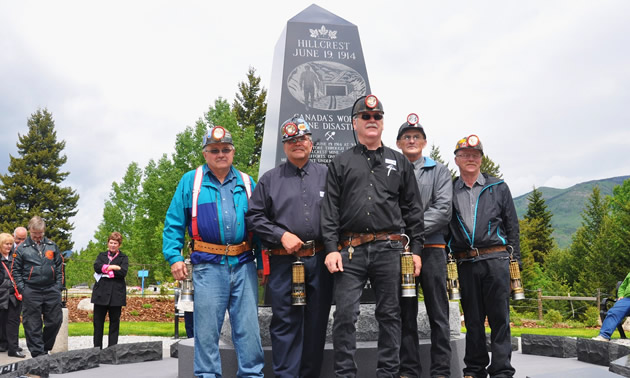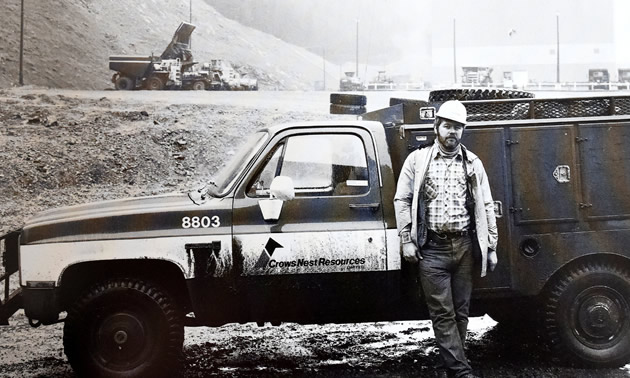Third-generation coal miner and local historian
John Kinnear's avocation is the history of mining in the Elk Valley, especially honouring those we've lost

In 2014, John Kinnear (centre) was part of an honour guard at the 100th anniversary of the Hillcrest Mine Disaster, when 189 men were lost. — Photo courtesy John Kinnear
John Kinnear grew up in the coal mines of southeastern British Columbia. Before him, his father and grandfather were both miners as well. Now retired from mining, Kinnear dedicates his time to studying and sharing the stories of coal miners who have tragically passed. He draws attention to the endurance of their families and to the personal strength they had to return to work after each disaster that struck the valley.
His father often described what it was like to work underground in the early years of mining. Perhaps it was these stories that sparked Kinnear's interest in the history of mining. “When you mine underground, the deeper you get, the more pressure you have on the coal," Kinnear said. "There is a couple thousand feet of cover over top of you, and it will start to squeeze.” Gas bumps caused what felt like small underground earthquakes, and the overhead pressure forced the walls to close around workers. Sometimes the walls completely caved, trapping miners in fast graves. The conditions, to say the least, were dangerous.
His mining vocation
While studying at the Southern Alberta Institute of Technology in the 1960s, Kinnear tried his own hand at conventional underground mining. “At that point, fatalities were relatively rare,” he said, making the trek underground slightly more bearable. Despite the improvements, working underground was still hard work. Many new hires quit after two days on the job. “They would go back the second day because they didn’t believe what they went through,” he joked.
"(As a summer student,) I caught a bus that took us 20 miles north to an underground mine,” he said. After changing into their work clothes, the men would hop into the coal cars attached to a diesel locomotive and begin their descent underground. Their work stations were up to two and a half miles into the ridge. “I was never afraid,” Kinnear said. Adjusting to underground darkness is difficult because “you can’t see your hand under your face,” he said. Although the conditions had improved since his father’s time in the mines, the comradery among underground miners remained the same: “The comradery gives comfort,” Kinnear said.
After completing his technical institute degree, he returned to the mines where he worked in a handful of roles until his retirement. He was a draftsman, surveyor, geological technician, coal quality co-ordinator, and a drill and blast technician at Teck’s Line Creek Mine in the Upper Elk Valley. “I’ve seen the evolution of mining and the evolution of mining safety,” he said.
His history avocation
What truly interested Kinnear throughout his career was the history of mining in the Elk Valley. “I discovered the old Crow's Nest Pass Coal Company archives in the basement of Fernie City Hall,” he said. “It was mind blowing when I found the map that showed where 130 men were killed in one day in a terrible blast. I became hooked on coal mining history.”

John Kinnear in 1984. He worked as a draftsman and surveyor at Teck's Line Creek Mine for 31 years. — Photo courtesy Lawrence Chrismas
Kinnear has studied mining history for 35 years now and has written plenty of articles about the topic. “When you study mining history, you get a little cynical,” he said, referring to the lack of safety practices implemented in the early mines. “Every time a miner was killed, no one was charged or confronted. Lots of times no changes were ever made. That’s just the way it was.” The rippling impact was felt each time throughout the communities in the valley.
Much of his work is meant to honour those who were lost before safety standards improved in the coal mines. For example, April 3, 2017, marks the Balmer North mine explosion’s 50th anniversary. This explosion took 15 lives. “Some described it like a thousand cases of dynamite going off,” said Kinnear. “The smoke belched across the valley. People heard it everywhere.”
Kinnear will be speaking at Sparwood’s ceremony in April honouring the Balmer North's 15 losses as well as honouring the total of 181 men lost in the Elk Valley mines from 1901 to present day. The District of Sparwood has commissioned a statue of a coal miner and a memorial wall naming the 181 men. As a third-generation coal miner and local historian, Kinnear is perfect for the role. “I spoke at Hillcrest (a different mining location nearby) in 2000 when we commemorated the 189 men lost on June 14, 1914, and I felt like they were watching from above. It was important to me to give a strong acknowledgment and to make people more aware of what it was like back then.”
What Kinnear genuinely hopes to draw attention to is the hardships that the miners and their families endured in the early years of underground mining. This elite group of workers had tremendous comradery to keep them going. Their remembered spirit is similar to his own experiences while working underground in the '60s, although he can’t personally imagine the extremes of their unsafe working conditions. “The true coal miner was the one who went underground and endured the conditions,” he said.
Fortunately, the landscape of mining has evolved. “In the old days it was the miners who worked hard to make sure that their kids wouldn’t have to go into the mine,” he said. “That was paramount for them because they didn’t want their kids to face the conditions that they had to face.”
Now, miners are equipment operators working in one of the safest fields. “The changes are spectacular. The mining life that I retired from in 2011 was a great career for me,” Kinnear said. Returning to the same example of Balmer North, only one life has been lost since the notorious explosion that shook the valley so long ago.
“Recognizing and commemorating those that have gone before us is really important,” he said. “In places like Drumheller, Hillcrest, Bellevue, Fernie and now in Sparwood, we choose to honour those lives.”




